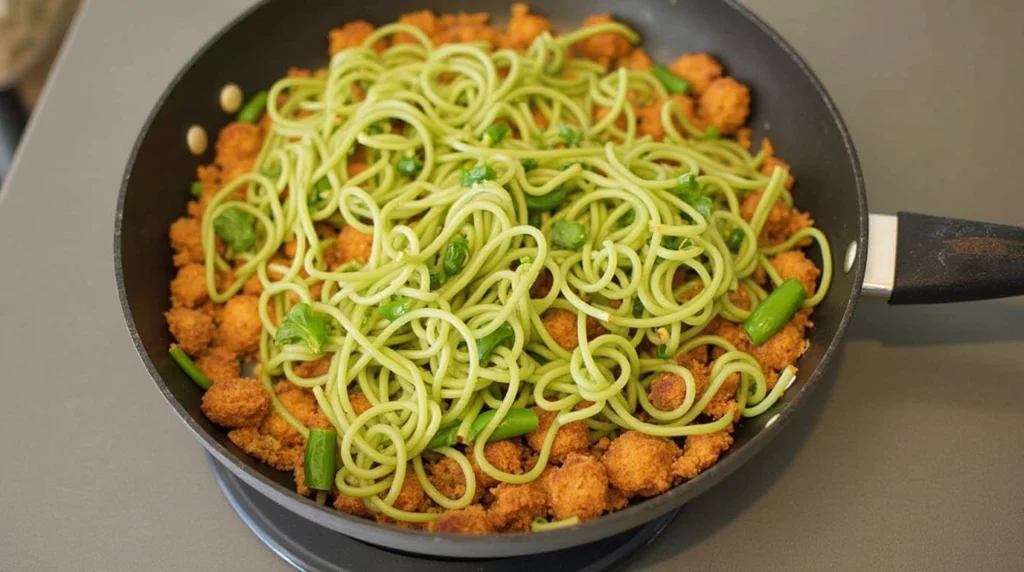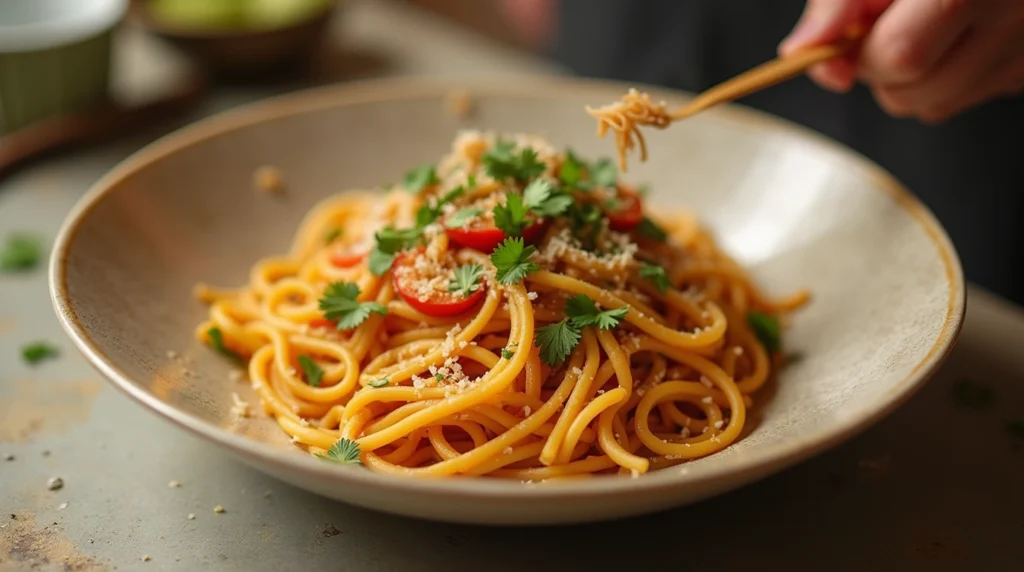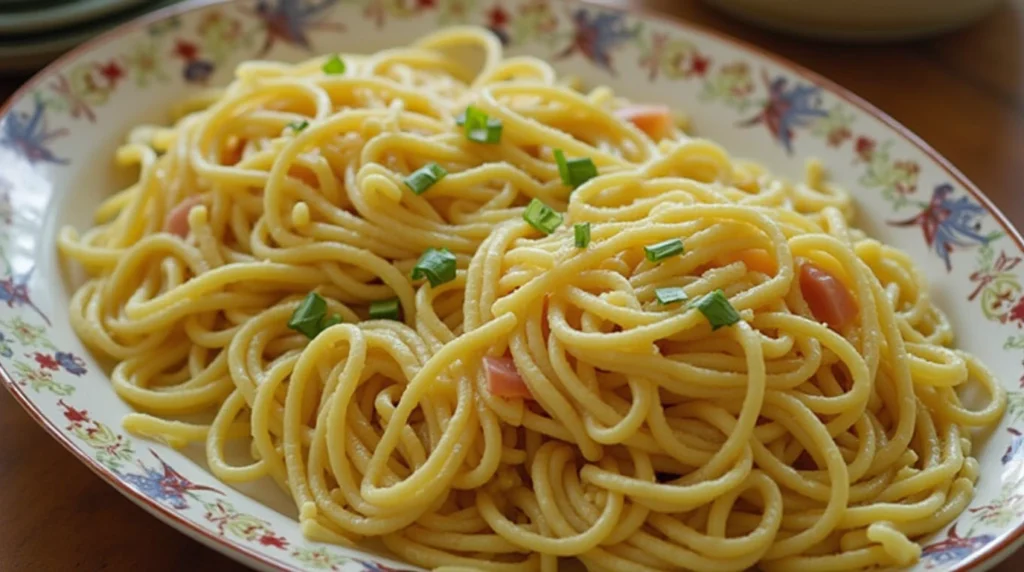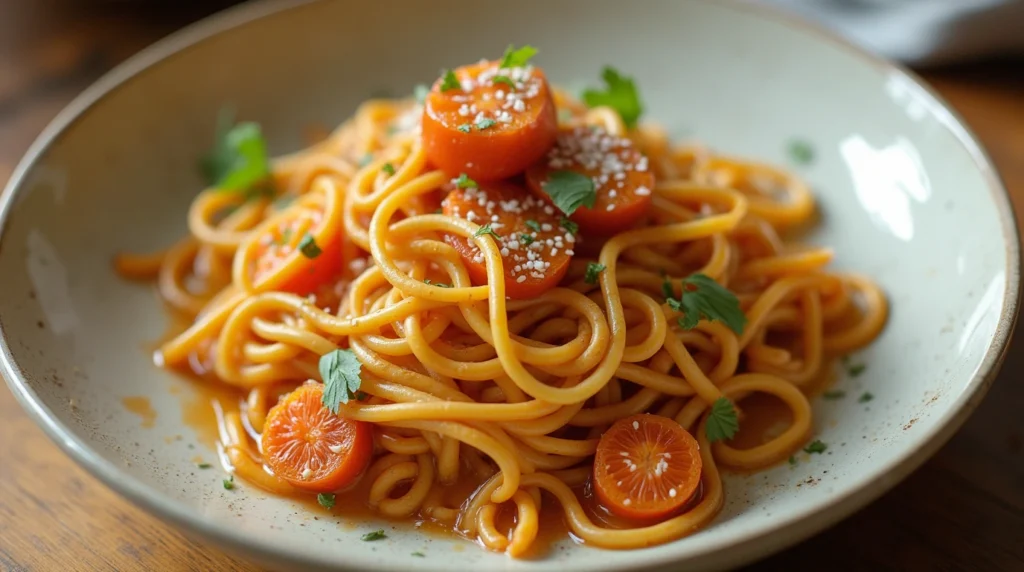Introduction

If you’ve ever tried to make zoodles (zucchini noodles) at home, you know the struggle of getting the perfect texture. Zoodles are a fantastic, low-carb alternative to traditional pasta, but they can often turn out soggy and watery, leaving you frustrated. But don’t worry—you’re not alone! Many home cooks face this challenge. The good news? With the right preparation and cooking techniques, you can easily make zoodles that are firm, flavorful, and perfectly textured. In this article, we’ll explore why zoodles become soggy and, more importantly, how you can avoid that by following simple yet effective methods. By the end, you’ll be able to cook zoodles that are crisp and delicious every time!
What Makes Zoodles Soggy?
To understand how to cook zoodles without them becoming soggy, it’s essential to know why they end up watery in the first place. Here are the key culprits:
Moisture Content of Zucchini
Zucchini is naturally composed of around 95% water, which is great for hydration but not ideal for creating perfectly firm zoodles. When you spiralize zucchini, it releases moisture, and if that moisture isn’t handled properly, your zoodles will become soggy. Understanding this will help you tackle the problem before you even start cooking.
Overcooking Zoodles
Another reason for soggy zoodles is overcooking. Zucchini noodles cook quickly—usually in just a few minutes—so if you leave them in the pan too long, they’ll release more water, resulting in mushy, soggy noodles. Keeping an eye on the cooking time is key to achieving the right texture.
Excess Water in the Pan
Water released from the zucchini can pool in the pan, making your zoodles soggy. This happens when the heat is too low, or if you’re using a cooking method that doesn’t allow the moisture to evaporate quickly enough. Avoiding this common mistake will ensure your zoodles stay firm and flavorful.
How to Prepare Zucchini for Cooking to Avoid Sogginess
Before you even get to the cooking part, preparation is essential to prevent sogginess. Here’s how you can prep zucchini properly for the best zoodles:
Use a Spiralizer for Perfect Zoodles
Using a spiralizer is the best way to create uniform, noodle-like zucchini strips that cook evenly. The spiralizer ensures your zoodles are the perfect size and thickness for optimal cooking, so they don’t get mushy.
Salt to Draw Out Excess Water
Salting zucchini before cooking is a trick used by many chefs. Once you spiralize your zucchini, sprinkle some salt on it and let it sit for 10–15 minutes. The salt will draw out excess moisture from the zucchini, which you can then blot away with a paper towel. This step reduces the likelihood of watery zoodles.
Patting Dry with Paper Towels
After salting and allowing the zucchini to sit, use paper towels to blot away any excess moisture. This step ensures you’re starting with dry zoodles, which prevents water from pooling in your pan during cooking.
The Best Cooking Methods to Keep Zoodles Firm
Now that your zoodles are prepped, it’s time to cook them. The way you cook zoodles is just as important as how you prepare them. Here are the best methods to ensure your zoodles stay firm:
Sautéing Zoodles in Olive Oil
Sautéing is the ideal method for cooking zoodles because it allows the moisture to evaporate quickly, keeping the zoodles firm. Heat a little olive oil in a pan and cook the zoodles for 2-4 minutes, tossing frequently. You’ll want to keep the heat medium-high to ensure that the zoodles cook quickly and don’t release too much water.
Using High Heat to Quickly Cook Zoodles
Cooking zoodles on high heat is crucial for preserving their texture. High heat allows the moisture to evaporate quickly and ensures the zoodles stay crisp. If you cook them over low heat, they’ll release too much moisture and become soggy.
Avoid Boiling or Steaming Zoodles
While it might seem like a good idea to boil or steam zoodles, these methods tend to make them watery and limp. Instead, stick to sautéing or stir-frying to retain the zoodles’ firmness and natural flavor.
Flavoring Zoodles Without Making Them Soggy
Zoodles are versatile and can be seasoned in many ways, but you’ll want to add flavor without increasing moisture. Here’s how to do it:
Adding Garlic and Herbs
Garlic, basil, and other fresh herbs are perfect for adding flavor to zoodles without making them soggy. Sauté the garlic in olive oil for a minute before adding your zoodles, then finish with fresh herbs for a burst of flavor.
Tossing with Pesto or Tomato Sauce
If you want to add sauce to your zoodles, be mindful of the moisture content. Use a thick pesto or a sauce that isn’t too watery. Toss your zoodles gently to coat them in sauce without making them too soggy.
Top with Grated Parmesan or Nutritional Yeast
Sprinkle some grated Parmesan or nutritional yeast on top of your zoodles for added flavor and texture. Both options add a savory kick without contributing to sogginess.

How to Store Zoodles for Meal Prep Without Losing Their Firmness
If you like to meal prep, you might be wondering how to store zoodles without them becoming soggy. Here are some tips:
Storing Zoodles Pre-Cooked
If you’re planning to store cooked zoodles, make sure they’re fully dried before placing them in the fridge. You can store them in an airtight container for 2-3 days. To prevent moisture buildup, place a paper towel in the container to absorb excess water.
Freezing Zoodles for Later Use
Freezing zoodles is a great way to preserve them. To freeze, first blanch them in boiling water for 1-2 minutes, then shock them in ice water. Pat them dry and store in freezer bags. This method keeps them firm when reheated.
Reheating Zoodles
When reheating zoodles, avoid using a microwave, as it can make them soggy. Instead, heat them in a pan over medium-high heat for a few minutes until they’re warm and crisp again.
The Science Behind Zoodle Texture
Understanding the science behind why zucchini becomes soggy when cooked can help you further improve your cooking methods. The more you know about the vegetable you’re working with, the better you can adjust your techniques for perfect zoodles every time.
Water Content and Its Role in Cooking
Zucchini’s high water content is the primary reason why it can become soggy. When heat is applied, the cells in the zucchini release this moisture. If this water isn’t removed or managed, it will pool in the pan, creating a soggy mess. This makes it difficult to get that firm, pasta-like texture we’re aiming for when cooking zoodles. By salting and drying out the zucchini before cooking, you’re essentially mitigating this issue and preparing the vegetable to hold its texture when exposed to heat.
The Effect of Heat on Zucchini
Heat is a critical factor in preserving the texture of your zoodles. When you cook zucchini at lower temperatures, the water within the zucchini slowly leaks out, causing it to become mushy. High heat allows the moisture to evaporate quickly, sealing the zoodles’ texture while retaining that firm, crunchy bite.
Creative Ways to Serve Zoodles Without Making Them Soggy
Zoodles can be a fun and healthy alternative to traditional pasta, but you can also get creative with how you serve them. From pairing with various sauces to incorporating them into unique dishes, here are some creative ideas to enjoy your zoodles without sogginess:
Zoodle Stir-Fry
One of the best ways to keep zoodles from becoming soggy is to use them in a stir-fry. The high heat of stir-frying will ensure the zoodles retain their firmness. Toss them with your favorite protein—like shrimp, chicken, or tofu—and vegetables for a flavorful, low-carb meal.
- Pro tip: Make sure your stir-fry sauce isn’t too watery to avoid adding extra moisture to the zoodles.
Zoodles in Soup
If you’re craving a warm, comforting bowl of soup, zoodles make an excellent noodle replacement. However, you’ll want to add them towards the end of cooking to prevent them from soaking up too much liquid. Let them cook for just a few minutes until they’re tender but still firm.
- Pro tip: If you want to avoid soggy zoodles in your soup, consider serving the zoodles separately and adding them to the soup just before eating.
Zoodle Salad
Zoodles can also be used in fresh salads. After spiralizing, you can serve them raw or briefly toss them in olive oil and herbs for a light, refreshing dish. Pair with cherry tomatoes, olives, and feta cheese for a Mediterranean-style salad that’s both healthy and satisfying.
- Pro tip: If you’re making a zoodle salad in advance, store the zoodles separately from the dressing to prevent them from becoming too soggy.

Troubleshooting Common Zoodle Problems
Even with the best preparation, sometimes things don’t go as planned. Here’s a quick guide to troubleshoot common zoodle problems you may encounter while cooking:
Zoodles are Too Watery
If you find that your zoodles are too watery even after following the prep methods, it’s likely that they weren’t dried enough before cooking. To fix this, drain the zoodles in a colander and give them an additional blotting with paper towels. You can also try cooking them over higher heat to evaporate the excess moisture.
Zoodles Are Mushy or Limp
Mushy or limp zoodles often indicate that they’ve been overcooked. Zoodles should only take 2-4 minutes to cook, depending on the thickness of the strips. If they’re mushy, you may need to adjust your cooking time. If you’re using a pan, ensure the heat is medium-high to avoid overcooking.
Zoodles Are Too Crunchy
If your zoodles are too crunchy for your liking, you can sauté them for an additional minute or two, but be careful not to overdo it. Alternatively, you can also steam or blanch them for a very short time to soften them while keeping their texture intact.
Why You Should Try Zoodles in Your Diet
Zoodles aren’t just a great alternative for reducing carbs—they also offer a variety of health benefits that make them worth incorporating into your diet.
Low-Carb, Low-Calorie Option
Zoodles are naturally low in calories and carbs, making them the perfect pasta alternative for anyone following a low-carb or ketogenic diet. Replacing pasta with zucchini noodles can help you reduce calorie intake without sacrificing satisfaction.
Packed with Nutrients
Zucchini is an excellent source of vitamins and minerals, including vitamin C, potassium, and antioxidants. It’s also high in fiber, which promotes digestive health. By swapping out traditional pasta for zoodles, you’re adding a nutrient-rich, vegetable-packed dish to your meals.
Great for Weight Loss
Because zoodles are low in calories but high in fiber and water content, they help keep you feeling full longer. This can support weight loss goals while still allowing you to enjoy a satisfying, hearty meal.
Zoodle Recipe Variations to Try
Now that you’ve mastered the basics of cooking zoodles, let’s take a look at some delicious recipe ideas you can try that will make your zoodles anything but boring:
Zoodles with Creamy Avocado Sauce
For a rich and creamy pasta dish without the guilt, toss zoodles with a homemade avocado sauce made from ripe avocado, garlic, lemon juice, and olive oil. The creaminess of the avocado pairs perfectly with the firm texture of zoodles, creating a satisfying dish that’s both light and indulgent.
Zoodle Carbonara
A low-carb twist on the classic Italian dish, zoodle carbonara uses zucchini noodles as a base for a rich, creamy sauce made with eggs, Parmesan, and pancetta. The crispy pancetta adds a nice crunch, complementing the zoodles’ firm texture.
Zoodles with Spicy Peanut Sauce
For a burst of flavor, toss your zoodles in a spicy peanut sauce made with peanut butter, soy sauce, garlic, and chili flakes. The peanut sauce coats the zoodles perfectly, giving them an extra punch without making them soggy.

Conclusion
Cooking zoodles doesn’t have to be a tricky task. By following the tips and methods outlined in this article, you can make zoodles that are firm, flavorful, and far from soggy. Whether you’re preparing a quick weeknight dinner or meal prepping for the week, zoodles are a healthy, low-carb alternative to pasta that you can enjoy without the worry of sogginess.
So, the next time you cook zoodles, try out these techniques to ensure they stay crispy and delicious. And don’t forget to share your favorite zoodle recipe or cooking method in the comments below—we’d love to hear how you make your perfect zoodles!
FAQ Section
Q1: How do I prevent my zoodles from becoming soggy when cooking them?
To prevent soggy zoodles, make sure to spiralize your zucchini, salt it to draw out moisture, pat it dry, and sauté on medium-high heat. Avoid boiling or steaming.
Q2: Can I make zoodles in advance without them getting soggy?
Yes! You can prepare zoodles ahead of time by spiralizing and salting them to remove excess moisture. Store them in an airtight container with a paper towel to absorb moisture.
Q3: What’s the best way to flavor zoodles without making them soggy?
Add garlic, fresh herbs, and thick sauces like pesto or tomato sauce to avoid extra moisture. Top with Parmesan or nutritional yeast for added flavor.
Q4: Can I freeze zoodles for later use?
Yes! To freeze zoodles, blanch them for 1-2 minutes, shock in ice water, dry thoroughly, and store in freezer bags. Reheat in a pan for best results.
Recipe Table: Zoodle Ingredients
| Ingredient | Quantity | Notes |
|---|---|---|
| Zucchini | 2 large | Spiralized into noodles |
| Olive Oil | 1 tbsp | For sautéing |
| Garlic | 2 cloves | Minced |
| Fresh Basil | 1 tbsp | Chopped (optional) |
| Parmesan or Nutritional Yeast | 2 tbsp | For topping |
| Salt | 1 tsp | To draw out moisture from zucchini |
